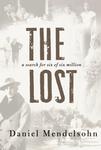Losing Ourselves in the Archives of Life

As I was suffering through travel delays in various airports recently, the most awful (for me) scenario occurred – I ran out of reading material. Faced with the prospects of many more hours of weather snarls, I made my way to a small newsstand and looked for the heftiest book of interest I could find. Fortunately, I acquired a copy of Daniel Mendelsohn’s 500 page The Lost: A Search for Six of Six Million (New York: HarperCollins, 2006), ISBN 10: 0-06-054297-7. This is a book I had read rave reviews about, and it was one I knew discussed the use of archival records. As I quickly became engrossed in the book, the delays became more bearable and time flew by. The Lost reads like a novel, contains both amusing and depressing anecdotes about Mendelsohn’s search to learn more about the family he lost in the Holocaust, and depicts a moving story about loss and remembrance.
The author, a faculty member at Bard College, tracks the events concerning the loss of six of his family members who lived in a small Ukrainian town and who were murdered by the Germans during World War Two. Mendelsohn discusses his examination of the family archives, the challenges posed by scattered and incomplete documentary materials, and the relating of various stories to what the documents seem to tell him. Mendelsohn describes how he had become the family’s official historian by the age of 15, relating how one afternoon visit with his grandfather provided an opportunity to gain some knowledge of the family’s documentation, indicating “he’d wanted my help in cleaning out a lot of old boxes of ‘useless things,’ as he called them, and I sat next to him for a few hours one day, tossing things he was handing me – packets of letters wrapped in rubber bands or string, old driver’s licenses, articles from Reader’s Digest that he’d town put – into a tall kitchen garbage pail lined with a white plastic bag” (p. 59). Most of us can identify with this experience, although few of us wind up becoming so absorbed as Mendelsohn ultimately does, traveling around the world to look at other sources and to talk with distant relatives and their friends and acquaintances.
Prompted by some disturbing revelations about the fate of these family members, the initial reluctance of eyewitnesses to discuss the tragic events, and some gaps in the evidence of the past, Mendelsohn “started to wonder, then, how many other traces she had left behind, how many other clues might be out there, floating in Internet postings and buried in archives that I wouldn’t even know were relevant because I had so little to go on, that I wouldn’t even know were relevant even when I saw them” (p. 63). Indeed, one can read this book as if it is a mystery, with Mendelsohn as the sleuth searching for clues, many of which lead to absolute dead ends, and all relating to an entire village that essentially disappeared in the 1940s. The author discovers Shlomo Adler, an individual dedicated to keeping in touch with the whereabouts of the dispersed survivors of the village. Visiting Adler, Mendelsohn finds a bedroom transformed into an office: “Everywhere you look, papers spill from boxes crammed onto shelves, and loose-leaf notebooks are stacked one of top of another: dominating the room, sitting atop a smallish desk that it dwarfs, is a large beige computer monitor. It is from this room that Shlomo does his Internet research and Web browsing, and keeps track of the other Bolechowers, sending them e-mails and letters, occasionally sending out his samizdat newsletters and, most important, the yearly reminders that go out not only to the survivors themselves but to their relatives and friends and, indeed, anyone who might have anything to do with Bolechow, which is to say people like me, about the annual Bolechow memorial service that he organizes” (pp. 395-396).
What is very interesting about The Lost is Mendelsohn’s painstaking efforts to go to where every possible shred of evidence might be and the manner in which he describes his experiences, such as when he ventures to Auschwitz: “One reason to go to Auschwitz is that the entire site is a gigantic piece of evidence, and in this respect seeing the piles of eyeglasses or shoes themselves, as opposed to merely knowing about them or seeing photographs or videos of the piles of eyeglasses or shoes or luggage, is more useful in conveying what happened.” He notes that another reason has to do with sentimentality: “You go to Auschwitz” for the same reason “you go to a cemetery, which is something that Auschwitz also happens to be: to acknowledge the claims of the dead” (p. 113). Mendelsohn acknowledges what others have also observed, that there are limits to what can be experience in museums and other repositories; they “can give us only the dimmest comprehension of what the event itself was like” (p. 237.
What Mendelsohn has accomplished is to give us an important, personal glimpse into a difficult, seemingly impossible, research project. Towards the end of the book Mendelsohn reflects on the relationship of proximity and distance, where “proximity brings you closer to what happened, is responsible for the facts we glean, the artifacts we possess, the verbatim quotations of what people said; but distance is what makes possible the story of what happened, is precisely what gives someone the freedom to organize and shape those bits into a pleasing and coherent whole. . . “(p. 417). Another way of considering this is to sense that what Mendelsohn is describing are the most intimate thoughts of a researcher struggling to build a story, with meaning, when he is not even sure what the story is really about. Too often we observe these researchers, and assist them, but we don’t always understand them. The Lost helps us do that now.

